ProAc Future One loudspeaker
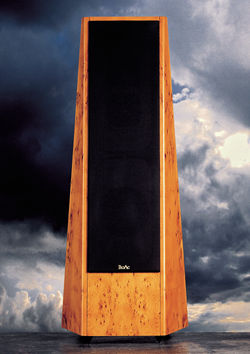 Given how many years he’s been at it, how many other speakers he’s built, and how different the One is from any of those earlier designs you may have read about, owned, or may still own, Tyler could just as accurately have said: “I have spent an entire career building speakers I did not want to build. Until now.” Not the optimal way to spend a career. Or is Tyler taking his cue from Charles Mingus, who, when asked to characterize the quality of his latest release, would invariably say, “This is the greatest record I’ve ever made”?
Given how many years he’s been at it, how many other speakers he’s built, and how different the One is from any of those earlier designs you may have read about, owned, or may still own, Tyler could just as accurately have said: “I have spent an entire career building speakers I did not want to build. Until now.” Not the optimal way to spend a career. Or is Tyler taking his cue from Charles Mingus, who, when asked to characterize the quality of his latest release, would invariably say, “This is the greatest record I’ve ever made”?
The Future One is unlike any ProAc you’ve ever seen or heard. It has a ribbon tweeter, an open-baffle midrange driver, and asymmetrical, bottom-ported bass loading. Why the sudden shift? It turns out that one of Tyler’s first designs, 25 years ago, used a Decca ribbon tweeter, a Quad electrostatic midrange element, and a cone woofer. But it wasn’t really practical for several reasons, and Tyler moved on to the more familiar and much-heralded ProAc moving-coil designs, which, as we now know, were not what he really wanted to be building. But the Future is. Tyler is at last building the speaker of his dreams because he’s finally found a reliable ribbon tweeter that performs to his requirements, and he thinks he’s figured out a way to integrate the bottom and midrange with it.
Appearance and Construction
Chest-high (4′) and, at 75 lbs, surprisingly lightweight for a ProAc floorstander, the wedge-shaped, three-driver Future One carries a heavyweight price of $10,000/pair. This is due in part to the difficulties involved in making the complex cabinets, each of which is hand-built in the UK and takes over 16 hours to assemble. The enclosure is relatively wide (19½” at the base, 13″ at the top), with a rear-sloping baffle, and there’s not a parallel cabinet wall in (or out of) sight. All surfaces—front, sides, rear—are beautifully finished in a choice of nine real-wood veneers. The yew review samples got two thumbs up from Mrs. Fremer.
The three drivers are vertically aligned and consist of a 7″ ScanSpeak carbon-fiber–impregnated paper-cone woofer designed to ProAc’s specs, crossed over at 290Hz (at 12dB/octave) to a 5″ transparent polypropylene-cone midrange with integral phase plug, which hands off the signal at 3.5kHz (18dB/octave) to the ca 2″ ribbon tweeter, said to be no thicker than a human hair. ProAc claims that the custom-built ribbon has a response out to 30kHz, but they’re not saying who manufactures it.
There’s a big problem with fast, exotic tweeters: How do you get them to blend effectively with the slower midrange and bass drivers? Tyler’s solution is to operate the midrange unit in free air, which eliminates back-of-cabinet reflections and allows the driver to move unhindered. A rear-cabinet flare is said to help couple the midrange driver’s backwave to the air, dissipating it and preventing it from interfering with the front wave. In addition, the rear of the open tweeter/midrange baffle is lined with foam damping material to further reduce the possibility of reflected energy. The woofer is loaded into a bottom-ported, heavily braced and damped asymmetrical enclosure said to greatly reduce standing waves.
Set Up and Broken In
The Future One sits on a pair of cabinet-mounted cones at the front and a pair of stabilizer bars at the rear, these also fitted with cones. The bars jut out the speaker’s rear, allowing for some adjustment of rake angle, but I didn’t find the One particularly sensitive to changes in verticality.
More important in getting the most from the Future One was toe-in. I got the best combination of smooth extension, appropriate soundstaging, and image focus with the tweeter axes crossing just behind my ears, which meant that the speakers were toed-in but not aimed directly at my listening position about 8′ away. The ProAcs produced their best tonal balance when placed near where the Sonus Faber Amatis work best in my room: about 3′ from the front wall, 2′ from the side walls, and about 9′ apart. Of course, all rooms are different, but I’ve learned one thing from placing loudspeakers so close to the front wall: such proximity in no way inhibits the development of soundstage depth.
The Future One is biwirable via two pairs of high-quality rhodium binding posts. ProAc obviously recommends biwiring: the “jumper” provided is a thick pin that, if you try to use it, leaves a gap between the nut and the post so wide that any spade lug known to modern audiophilia will simply fall out. (Between this and the Musical Fidelity Nu-Vista‘s steroidal binding posts, what is wrong with those Limeys?) I ended up biwiring, using Yamamura 6000 on top and Musical Fidelity Nu-Vista OCC on bottom. I tried a few other cables in my wire arsenal, just to be sure cabling wasn’t affecting the sonic results. It wasn’t.
While the Future Ones had been broken in somewhat by the importer, he warned me that they needed more. He was right. Out of the box, the tweeter’s incredible resolution and clarity were obvious—but so was the tweeter, which was bright if still sweet, and only marginally connected to the sound of the rest of the speaker. But after a week of constant use the tweeter had mellowed considerably, and the two years of work Tyler is said to have put into the design and final voicing of the Future One was bearing delicate, detailed sonic fruit.
Balance and Resolution
The ProAc Response 2.5, which I reviewed in January 1996 (Stereophile, Vol.19 No.1), and the other ProAc towers I’ve heard, share a rich, warm, generous, almost ripe sonic balance. But forget whatever you might think of the big “ProAc sound”—the Future One is cut from finer cloth. It was much more lean, fast, and nimble, while still managing to sound sweet and rich.
While the single ported 7″ woofer is said to extend down to 25Hz, the One’s overall balance is on the trim side, particularly in the midbass. Though the Ones occasionally surprised me by cleanly plumbing the depths, lovers of pipe-organ music will need to augment them with a subwoofer. But everyone else should be satisfied with the One’s firm foundation, and absolutely thrilled by its superb bottom-end pitch definition.
The One’s rendering and delineation of bass and tom-tom drum pitches was stunning. For instance: Keith Moon’s taut tom-tom rolls on an original British pressing of Tommy (Track 613 013/14) were delivered with superb tunefulness. The sensation of stick on skin was convincing and ultra-satisfying, as was the overall rhythmic presentation. The bottom would have to be fast and lean to keep up with the ribbon tweeter, and Tyler has tuned the system to be so. Whatever the Future One gave up in bass weight was more than compensated for in bass character, tonality, and speed.
To get that high level of clean, tuneful bass requires outstanding midbass and a seamless transition into the lower midrange, and Tyler’s thinking seems to have worked perfectly. There was never a miscue or lack of continuity between the upper bass and lower midrange. The system was remarkably free of midbass coloration, thickness, or overhang. Where they had to be, the bottom octaves were fast, and never left behind.
While the midrange was rich and possessed electrostatic-like clarity (I said “like,” not “identical to”), the system’s single distinct coloration was a slight “cuppy” sound in the upper-mids. It was very subtle until I got behind the speaker. Then, not surprisingly, the midrange driver with the rear of its cone open to the air sounded quite hooty. But, of course, you’re not supposed to stand close behind a speaker, and in most placement situations you won’t be able to hear much of that backwave. Although I didn’t think any of the backwave was reflecting off the wall behind in my room, which is damped with squares of Sonex, there was still that slight coloration audible. Clearly, you don’t want to place your Future Ones too close to a reflective back wall, lest Dr. Bose come a-calling.
I don’t mean to dwell on what was a minor glitch, but this was the one area where I felt I could consistently “hear” the One. But it was subtle, easily ignored, and, finally, buried and forgotten.
Once the signal got up into the tweeter’s territory, it was clear sailing. I knew immediately that I was in earshot of an incredible performer: lightning-fast, highly resolving, ultra-extended, airy, unusually liquid—and free of wideband resonances, narrow, sharp peaks, or other kinds of obvious colorations and distortions. What a sweet, smooth tweeter Tyler has found! More important, he’s managed the near-impossible by mating it with other drivers to create a coherent, convincing, almost full-range system. In some ways the Future One reminded me of the Infinity Prelude, which I reviewed in May. Neither speaker sparkled, yet both revealed incredible amounts of detail without shining a spotlight.
I played the usual suspects—Dave Brubeck’s “Take Five” on Classic 45rpm vinyl, Janis Ian’s Breaking Silence (Analogue Productions), etc.—but so much information was unraveled from those tracks that, throughout the review period, I couldn’t help pulling out albums at random just to hear what new info I could glean. To further torture and delight myself, I also listened to CD-Rs I’d made using the Rockport System III Sirius turntable.
I listened to Elvis Costello’s Get Happy!! (F-Beat XX-LP1) and was amazed by the upper-octave details the tweeter sorted out that had previously been combined, and by the speaker’s ability to place Costello’s reverb-drenched, formerly indistinct backing harmonies in a three-dimensional space totally different from his main vocal.
The speaker’s airy openness did justice to the unforced brilliance of Mel Tormé and Friends at Marty’s (Finesse W2X37484). Tormé floated convincingly in three dimensions between the speakers, and Jay Leonhardt’s bass solo in “Let’s Take a Walk Around the Block” was reproduced with suppleness and harmonic fullness—all as boxlessly as a box speaker has ever rendered this recording in my listening room.
Sweet and extended, fast and full-bodied, and capable of stunning resolution of musical events occurring in the same or similar tonal territory, Tyler’s ribbon tweeter was clearly the star—but it was so effectively blended into the whole picture that it didn’t steal the show.
I was initially concerned about the Future One’s relatively wide, undamped, reflective front baffle. I was ready to hear high-frequency diffraction off of the baffle creating less-than-ideal imaging and soundstaging. I thought I would easily “hear” the speaker and “see it” in the sonic picture. That wasn’t the case. While I’ve heard speakers that can disappear more completely, creating a larger, more dramatic soundstage with more clearly defined instrumental imaging and layering, the Future Ones’ incredible resolution and transparency, their crystal-pure transient performance and superb image focus, more than compensated.
I spent a pleasant evening listening to much of the Ataulfo Argenta Edition boxed set (Alhambra/Alto Analogue AA006), comparing the much-maligned (in some quarters) versions of Concierto de Aranjuez, Noches en los Jardines de España, and Preludes e Intermedios with the London ffss versions (CS 6046 and CS 6152). I found the reissue’s transparency and jet-black backgrounds preferable to the Londons’ somewhat richer but more opaque midrange. The Future One’s rendering of the Spanish guitar was stunning, convincingly balancing the fast but non-sparkly sound of fingers on strings with the hollow body’s overtones, and effectively focusing the image in 3D space.
Aside from its mild midband coloration, the Future One’s other weakness was an inability to reproduce “grand gestures.” It could play loud (and yet is a clean, lively performer at low levels), but it was not an explosive, ultra-dynamic reproducer—particularly in the midband, where it was somewhat laid-back. The Future One was not bombastic, nor do I think it was designed to be so. But I don’t mean to leave you with the impression that, dynamically, it was seriously limited or “polite.” It didn’t knock me back in my seat with sheer dynamic weight, but it did a credible job of handling orchestral crescendos.
The Future One will not overwhelm you with harmonic riches à la the older ProAc towers. That’s not surprising: Tyler’s goal was to combine an electrostatic’s clarity, tonal neutrality, and high resolving power with a dynamic speaker’s non-fussy drive requirements, power handling, bass extension, and smooth, broad dispersion. The Future One is about fine detail, clarity, organization, speed, liquidity, rhythmic suppleness, and coherence.
Conclusion
Tactile, transparent, crystalline, and fast without being hard, bright, or analytical, the ProAc Future One fulfills Stuart Tyler’s goal of building a loudspeaker with all the desired qualities of electrostatic designs and none of their drawbacks. I drove the Future Ones with the solid-state Ayre K-1x preamplifier and hybrid Musical Fidelity Nu-Vista 300 power amplifier, and they never sounded bright or hard. I played LPs that were less than pristine and some that were chewed up, but despite the tweeter’s extension, the surface flaws were never spotlit, nor did they excite tweeter resonances that would have accentuated the occasional snaps, crackles, and pops.
The Future One didn’t throw me back in my seat, but it definitely drew me in with its lithe rhythmic performance and subjectively smooth and peak-free frequency response—that ribbon tweeter had me hearing new stuff in every recording I played. And despite their relatively small size (they’re definitely apartment-friendly), the Ones created a big, smooth, detailed, satisfying sound.
Is a pair of Future Ones worth $10,000? Only you and your accountant can answer that one…but I enjoyed every minute I spent with them.
Specifications
Description: Three-way, floorstanding, reflex-loaded loudspeaker: Drive-units: 2″ long (approximately) ribbon tweeter, 5″ polypropylene-cone midrange unit with phase plug, 7″ carbon-fiber–impregnated paper-cone woofer. Crossover frequencies: 290Hz, 3.5kHz. Frequency response: Not stated. Impedance: 8 ohms nominal. Sensitivity: 87dB/W/m.
Dimensions: 48″ H by 19½” W (base) and 13″ W (top) by 9″ D. Net weight: 75 lbs.
Finishes: Nine wood veneers.
Serial numbers of units reviewed: 141, 142.
Price: $10,000/pair. Approximate number of dealers: 35.
Measurements
The ProAc Future One was measured using my standard combination of a DRA Labs MLSSA PC card with a calibrated B&K 4006 microphone for the acoustic measurements, and an Audio Precision System One for the impedance. The ProAc’s impedance curves (fig.1) revealed the speaker to be a relatively benign load over much of the audioband, its resistance dropping below 5 ohms for only brief periods in the upper bass and midrange. However, a potentially demanding combination of 5.5 ohms magnitude and a 45º capacitive phase angle at 79Hz means tube amplifiers would best be used from their 4 ohm taps. The speaker’s sensitivity was average at 86dB(B)/2.83V/m, inconsequentially lower than the specified 87dB.
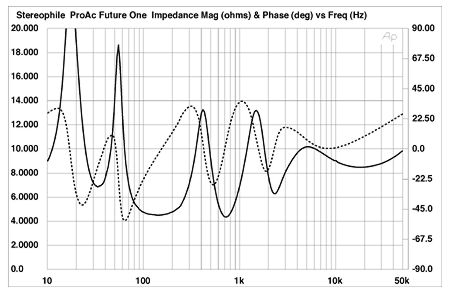
Fig.1 ProAc Future One, electrical impedance (solid) and phase (dashed). (2 ohms/vertical div.)
The Future One’s impedance traces are free from resonance-related wrinkles, and a cumulative spectral-decay plot calculated from the output of a simple accelerometer fastened to the center of a sidewall (fig.2) revealed no significant vibrational modes.
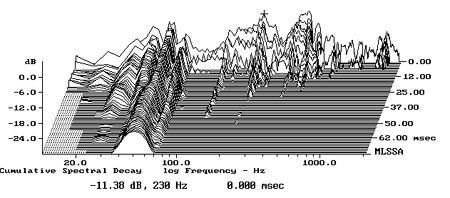
Fig.2 ProAc Future One, cumulative spectral-decay plot calculated from the output of an accelerometer fastened to the cabinet sidewall. (MLS driving voltage to speaker, 7.55V; measurement bandwidth, 2kHz.)
The saddle at 36Hz in the impedance magnitude trace indicates the tuning of the downward-firing port. Not coincidentally, this is the frequency of the minimum-motion point in the woofer’s response (fig.3). The port’s output peaks a little higher in frequency, however, and while there is some midrange spikiness in the port response, this is both well down in level and will be further suppressed by the fact that the port faces the floor. The woofer appears to cross over to the open-baffled midrange unit at around 350Hz with approximately symmetrical filter slopes. However, note the sharp discontinuity in the midrange driver’s output between 1kHz and 2kHz. I suspect that this behavior underlies the coloration noted by MF in his auditioning. Certainly I could also hear some slight cupped-hands coloration in the speaker’s presentation, which grew very much more pronounced when I moved behind the speaker. This behavior reminds me of the large Acarian Alón speakers, which feature similar dipolar midrange-unit mountings.
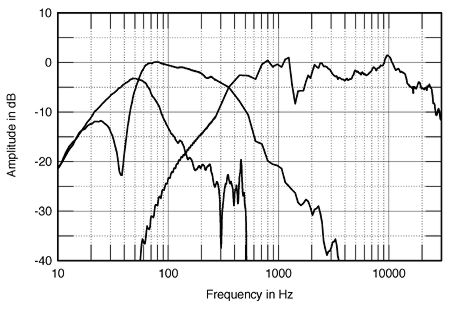
Fig.3 ProAc Future One, acoustic crossover on tweeter axis at 50″, corrected for microphone response, with the nearfield woofer and port responses plotted below 300Hz and 1kHz, respectively.
Fig.4 reveals how these individual responses sum on the tweeter axis at a microphone distance of 50″, averaged across a 30º horizontal window. The upper-midrange discontinuity is again readily apparent. The tweeter range seems slightly shelved-down, with a slight peak at 10kHz before a prematurely rolled-off top octave. The rise in the bass is partly due to the nearfield measurement technique, which assumes a 2pi environment for the drive-units. But the midbass region did sound a little elevated during my measurements.
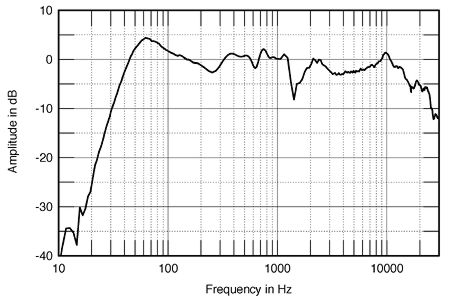
Fig.4 ProAc Future One, anechoic response on-axis at 50″, averaged across 30º horizontal window and corrected for microphone response, with the complex sum of the nearfield woofer and port responses plotted below 300Hz.
The Future One’s lateral dispersion is shown in two ways: fig.5 shows the speaker’s actual response, plotted at 5º intervals from 90º off-axis on one side of the tweeter axis to 90º on the other side; fig.6 shows just the differences between the off-axis responses and the response on the tweeter axis (which thus appears as a straight line). The cursor in fig.6 reveals a sharp off-axis notch in the octave between 300Hz and 600Hz, presumably due to the dipolar mounting of the midrange unit. But the top two octaves of the midrange unit’s passband show relatively uniform dispersion, and the crossover to the wide-dispersion tweeter is quite seamless. Fig.5 shows that the upper-midrange discontinuity in the on-axis behavior persists off-axis, which perhaps explains why MF and I found the coloration ubiquitous.

Fig.5 ProAc Future One, lateral response family at 50″, from back to front: responses 90º–5º off-axis, reference response on tweeter axis, responses 5º–90º off-axis.

Fig.6 ProAc Future One, lateral response family at 50″, normalized to response on tweeter axis, from back to front: differences in response 90º–5º off-axis, reference response, differences in response 5º–90º off-axis.
The overall tweeter output in the forward direction gently rises between 3kHz and 12kHz, which, coupled with the seamless join between the tweeter’s wide dispersion and that of the midrange unit, will tend to make the speaker’s in-room HF balance sound natural. In the vertical plane (not shown), the tweeter’s top octave doesn’t roll off so readily above that axis. Although the tweeter axis is a relatively high 41″ from the floor, a notch develops in the mid-treble if you sit lower than the midrange-unit axis.
Despite its sloped-back baffle, the Future One is not time-coherent. Its step response (fig.7), for example, shows the tweeter’s inverted output arriving a fraction of a millisecond before the midrange unit’s (also inverted), which then smoothly blends into the positive-polarity step from the woofer. The waterfall plot on the tweeter axis (fig.8) reveals a very clean output and a quick uniform decay in the tweeter’s passband. The upper-midrange discontinuity, however, is associated with some significant delayed energy, which is perhaps due to reflection of the backwave and the resultant interference rather than a resonance per se. Whatever the reason, the resultant slight cupped-hands coloration lets down what would otherwise be a very promising design.—John Atkinson

Fig.7 ProAc Future One, on-axis step response at 50″ (5ms time window, 30kHz bandwidth).

Fig.8 ProAc Future One, cumulative spectral-decay plot at 50″ (0.15ms risetime).





















